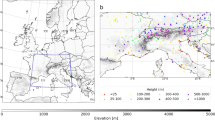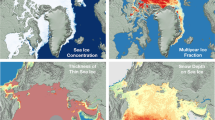Abstract
The scatterometer (SCAT) on-board China’s HY-2A satellite has the capability to provide high resolution wind vector information over the global ocean surface. These wind vector data produced by the HY-2A scatterometer (HY-2A SCAT) are available to the data assimilation system with real-time information of high accuracy. In this paper, two experiments are designed to investigate the impact of HY-2A SCAT data in the three-dimensional variational assimilation system for the Weather Research and Forecast model (WRF 3DVAR). The powerful Typhoon Bolaven, which struck South Korea in August 2012, is selected for this case study. The results clearly demonstrate that HY-2A SCAT data can effectively complement the scarce observations over the ocean surface and improve the prediction of the wind and pressure fields of a typhoon. The case study of Typhoon Bolaven exhibits the significant and positive impact of HY-2A SCAT data on the numerical prediction of the tropical cyclone track.
Similar content being viewed by others
References
Andrews P L, Bell R S (1998). Optimizing the United Kingdom Meteorological Office data assimilation for ERS-1 scatterometer winds. Mon Weather Rev, 126(3): 736–746
Barker D M, Huang W, Guo Y R, Bourgeois A J, Xiao Q N (2004). A three-dimensional variational data assimilation system for MM5: Implementation and initial results. Mon Weather Rev, 132(4): 897–914
de Chiara G, Janssen P, Hersbach H, Bormann N (2012). Assimilation of scatterometer winds at ECMWF. ECMWF, Shinfield Park, Reading, RG2 9AX, United Kingdom, 1–8
Dong X, Xu K, Liu H, Jiang J (2004). The radar altimeter and scatterometer of China’s HY-2 satellite. In: Geoscience and Remote Sensing Symposium, 2004. IGARSS’04. Proceedings. 2004 IEEE International. IEEE, 2004, (3): 1703–1706
Ebuchi N, Graber H C, Caruso M J (2002). Evaluation of wind vectors observed by QuikSCAT/SeaWinds using ocean buoy data. J Atmos Ocean Technol, 19(12): 2049–2062
Gu J F, Xiao Q N, Kuo Y H, Barker D M, Xue J S, Ma X X (2005). Assimilation and simulation of typhoon Rusa (2002) using the WRF system. Adv Atmos Sci, 22(3): 415–427
Hilburn K A, Wentz F J, Smith D K, Ashcroft P D (2006). Correcting active scatterometer data for the effects of rain using passive radiometer data. J Appl Meteorol Climatol, 45(3): 382–398
Hong S Y, Lim J O J (2006). The WRF single-moment 6-class microphysics scheme (WSM6). J Korean Meteor Soc, 42(2): 129–151
Ide K, Courtier P, Ghil M, Lorenc A C (1997). Unified notation for data assimilation: Operational, sequential, and variational. J Meteorol Soc Jpn, 75(1B): 181–189
Katsaros K B, Forde E B, Chang P, Liu W T (2001). QuikSCAT’s sea winds facilitates early identification of tropical depressions in 1999 hurricane season. Geophys Res Lett, 28(6): 1043–1046
Katsaros K B, Vachon P W, Liu W T, Black P G (2002). Microwave remote sensing of tropical cyclones from space. J Oceanogr, 58(1): 137–151
Leidner S M, Isaksen L, Hoffman R N (2003). Impact of NSCAT Winds on Tropical Cyclones in the ECMWF 4DVAR Assimilation System. Mon Weather Rev, 131(1): 3–26
Li X F, Zhang J A, Yang X F, Pichel W G, DeMaria M, Long D, Li Z (2013). Tropical Cyclone Morphology from Spaceborne Synthetic Aperture Radar. Bull Am Meteorol Soc, 94(2): 215–230
Lin M S (2008). The contribution of global ocean observation of continuity of HY-2 satellite. In: National Satellite Oceanic Application Service. SOA, China: 1–22
Liu W T (2002). Progress in Scatterometer Application. J Oceanogr, 58(1): 121–136
Lorenc A C (1986). Analysis method for numerical weather prediction. Q J R Meteorol Soc, 112(474): 1177–1194
Parrish D F, Derber J C (1992). The National Meteorological Center’s spectral statistical-interpolation analysis system. Mon Weather Rev, 120(8): 1747–1763
Prasad V S, Gupta A, Rajagopal E N, Basu S (2013). Impact of OSCAT surface wind data on T574L64 assimilation and forecasting system — a study involving tropical cyclone Thane. Curr Sci, 104(5): 627–631
Rogers R, Chen S, Tenerelli J, Willoughby H (2003). A numerical study of the impact of vertical shear on the distribution of rainfall in Hurricane Bonnie (1998). Mon Weather Rev, 131(8): 1577–1599
Rufenach C (1998). Comparison of four ERS-1 scatterometer wind retrieval algorithms with buoy measurements. J Atmos Ocean Technol, 15(1): 304–313
Shin H H, Hong S Y (2011). Intercomparison of planetary boundary-layer parametrizations in the WRF model for a single day from CASES-99. Boundary-Layer Meteorol, 139(2): 261–281
Singh K P, Gray A L, Hawkins R K, O’Neil R A (1986). The influence of surface oil on C-and Ku-band ocean backscatter. IEEE Trans Geosci Rem Sens, GE-24(5): 738–744
Skamarock W C, Klemp J B, Dudhia J (2001). Prototypes for the WRF (Weather Research and Forecasting) model. In: Preprints, Ninth Conf. Mesoscale Processes, J11–J15, Amer. Meteorol. Soc., Fort Lauderdale, FL
Thomas B R, Kent E C, Swail V R (2005). Methods to homogenize wind speeds from ships and buoys. Int J Climatol, 25(7): 979–995
Tomassini M, LeMeur D, Saunders R W (1998). Near-surface satellite wind observations of hurricanes and their impact on ECMWF model analyses and forecasts. Mon Weather Rev, 126(5): 1274–1286
Wang X, Liu L, Shi H, Dong X, Zhu D (2012). In-orbit calibration and performance evaluaiotn of HY-2 scatterometer. In: Geoscience and Remote Sensing Symposium (IGARSS), 2012 IEEE International IEEE: 4614–4616
Willemet J M, Lasserre-Bigorry A (2001). Satellite Data Assimilation: Impact on Tropical Cyclone Forecast
Yan J H (2004). China’S HY-1A ocean satellite and its applications. In: The Thirteenth Workshop of OMISAR, (2): 1–7
Yang X F, Li X F, Pichel W G, Li Z W (2011). Comparison of Ocean Surface Winds From ENVISAT ASAR, MetOp ASCAT Scatterometer, Buoy Measurements, and NOGAPS Model. IEEE Trans Geosci Rem Sens, 49(12): 4743–4750
Zhang F, Weng Y, Sippel J A, Meng Z, Bishop C H (2009). Cloudresolving hurricane initialization and prediction through assimilation of Doppler radar observations with an ensemble Kalman filter. Mon Weather Rev, 137(7): 2105–2125
Zhang W M, Cao X Q, Song J Q (2012). Design and implementation of four-dimensional variational data assimilation system constrained by the global spectral model. Acta Phys Sin, 61(24): 249202
Author information
Authors and Affiliations
Corresponding author
Additional information
Yi Yu received a B.S. degree in Computer Science and Technology from Hunan University, Changsha, China, in 2005 and an M.S. degree from National University of Defense Technology (NUDT), Changsha, China, in 2011.
During her M.S. degree program from 2008–2011, she researched the assimilation of high-resolution infrared sounders observation. Her research interests include infrared hyper-spectral processing, assimilation of scatterometers, and fast radiative transfer model studies.
Dr. Yu is a Ph. D. candidate in the College of Computer at NUDT.
Weimin Zhang received a B.S. degree from the Department of Mathematics at Sichuan University, Chengdu, China, in 1986 and a Ph.D. from the College of Computer at the National University of Defense Technology (NUDT), Changsha, China, in 2006.
Since 1989, he has been a teacher in the Institute of Software in the College of Computer at NUDT. He has participated in the development of the Yin He Global Spectral Model (YHGSM) and the four-dimensional variational (4DVAR) data assimilation system constrained by the global spectral model. His research interests include data assimilation, parallel computation, and numerical weather prediction.
Prof. Zhang is a doctoral supervisor. He was also a researcher in the College of Computer at NUDT.
Zhongyuan Wu received an M.S. degree from the Cold and Arid Regions Environmental and Engineering Research Institute, Chinese Academy of Sciences, Lanzhou, China, in 2011.
During his M.S. degree program, he researched the assimilation of radar data and numerical weather prediction. His research interests include the data assimilation of satellite observations and software development.
Mr. Wu has been an Assistant Engineer in the College of Computer at National University of Defense Technology.
Xiaofeng Yang received a B.S. degree in Environmental Science from Sichuan University, Chengdu, China, in 2005 and a Ph.D. degree in Cartography and Geographic Information Systems from the Institute of Remote Sensing Applications (IRSA), Chinese Academy of Sciences (CAS), Beijing, China, in 2010.
During his Ph.D. program, 2009–2010, he was a Visiting Research Scientist with the Department of Atmospheric and Oceanic Science, University of Maryland, College Park. From 2010 to 2012, he was an Assistant Researcher at IRSA/ CAS.
Since 2013, he has been with RADI/CAS as an Associate Researcher. His research interests include satellite oceanography, synthetic aperture radar image processing, and marine atmospheric boundary layer process studies. He has also participated in the development of various types of operational ocean products in China coastal waters from environmental satellite data.
Dr. Yang is a member of IEEE. He has also served as a reviewer of several international academic journals.
Xiaoqun Cao received B.S. and Ph.D. degrees in Meteorology from the People’s Liberation Army (PLA) University of Science and Technology in 2002 and 2007, respectively.
During his Ph.D. program, he participated in the development of the Yin He Global Spectral Model (YHGSM). His research interests include large-scale scientific computing, numerical weather prediction, and data assimilation of satellite observations.
Since 2007, Dr. Cao has been an Assistant Professor in the College of Computer in the National University of Defense Technology.
Mengbin Zhu received a B.S. degree from Tsinghua University, Beijing, China, in 2010 and a M.S. degree in Computer Science and Technology from the National University of Defense Technology (NUDT), Changsha, in 2012.
During his graduate degree program, 2010–2012, he implemented the assimilation of GPS radio occultation data in a 4DVAR system.
Since 2013, Dr. Zhu has been a Ph.D. candidate in the Institute of Software in the College of Computer at NUDT.
Rights and permissions
About this article
Cite this article
Yu, Y., Zhang, W., Wu, Z. et al. Assimilation of HY-2A scatterometer sea surface wind data in a 3DVAR data assimilation system—A case study of Typhoon Bolaven. Front. Earth Sci. 9, 192–201 (2015). https://doi.org/10.1007/s11707-014-0461-8
Received:
Accepted:
Published:
Issue Date:
DOI: https://doi.org/10.1007/s11707-014-0461-8




